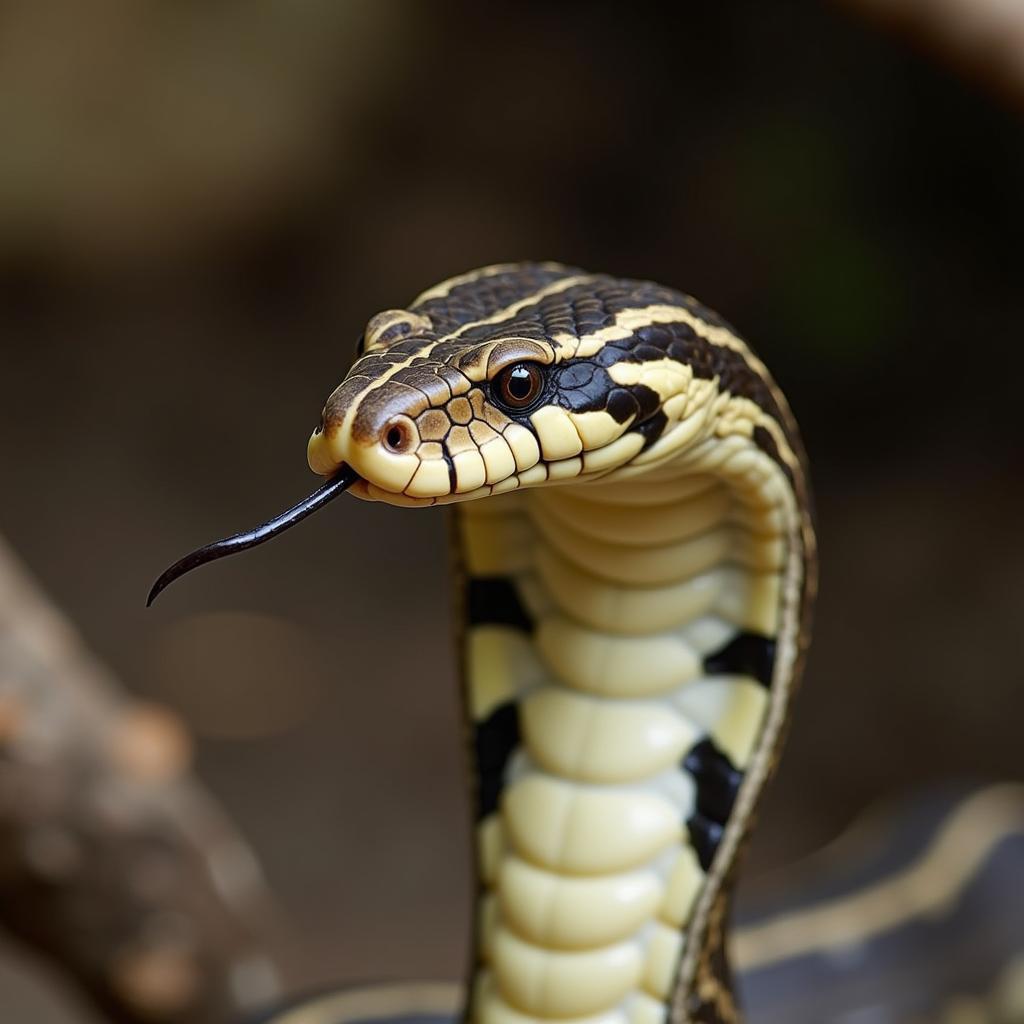Unveiling the African Cape Cobra: A Majestic and Dangerous Serpent
The African Cape Cobra (Naja nivea), a highly venomous snake, reigns supreme in the southern parts of Africa. This article delves into the captivating world of this iconic reptile, exploring its behavior, habitat, venom, and the crucial role it plays in the African ecosystem.  Close-up portrait of an African Cape Cobra showcasing its distinctive hood and markings.
Close-up portrait of an African Cape Cobra showcasing its distinctive hood and markings.
Understanding the African Cape Cobra’s Deadly Venom
The African Cape Cobra’s venom is a potent neurotoxin, affecting the nervous system and causing paralysis. Understanding its composition and effects is crucial for developing effective antivenom. Unlike some african snake species with cytotoxic venom, the Cape Cobra’s neurotoxic venom acts swiftly, disrupting nerve signals and leading to respiratory failure if left untreated. This makes it one of the most dangerous snakes in Africa.
What makes the Cape Cobra’s venom particularly dangerous is its rapid action. Symptoms can manifest within minutes, requiring immediate medical attention. These symptoms can include difficulty breathing, blurred vision, and eventually, paralysis.
The Importance of Antivenom
Antivenom is the only effective treatment for an African Cape Cobra bite. It is crucial to seek medical help immediately after a bite. Time is of the essence, as the venom can quickly overwhelm the body’s systems. The development and accessibility of antivenom are vital in regions where the Cape Cobra is prevalent.
Habitat and Distribution of the African Cape Cobra
The African Cape Cobra is found in a variety of habitats across southern Africa, including arid regions, savannas, and even mountainous areas. It demonstrates adaptability to diverse environments, thriving in dry, rocky landscapes as well as areas with more vegetation. This adaptability contributes to its wide distribution.
Adapting to Diverse Environments
The Cape Cobra’s ability to thrive in different habitats is a testament to its resilience. Its diet, consisting mainly of rodents, lizards, and other snakes, allows it to find sustenance in various environments. This adaptability also plays a role in its interactions with other species, including potential predators like african bird that kills snakes. Understanding these predator-prey relationships provides valuable insights into the complex dynamics of the African ecosystem.
The African Cape Cobra’s Behavior and Diet
The African Cape Cobra is a diurnal snake, meaning it is active during the day. It is known for its alertness and defensive posture, often raising its hood and hissing when threatened. This display serves as a warning to potential predators. The Cape Cobra is also an excellent climber and swimmer, further enhancing its hunting prowess.
Hunting and Feeding Habits
The Cape Cobra is an active hunter, using its speed and agility to capture its prey. Its diet consists primarily of small rodents, lizards, and other snakes. Its venom plays a crucial role in subduing its prey quickly and efficiently.
Dr. Sarah Jones, a herpetologist specializing in African venomous snakes, notes, “The Cape Cobra is a highly efficient predator, utilizing its venom to quickly incapacitate its prey. This minimizes the risk of injury to the snake during hunts.”
Conservation Status and Threats
While the African Cape Cobra is not currently listed as endangered, habitat loss and human-wildlife conflict pose significant threats to its populations. Understanding these challenges is vital for implementing effective conservation strategies.
Human-Wildlife Conflict
As human populations expand, encounters with the African Cape Cobra become more frequent, leading to potential conflicts. Education and awareness programs are essential to promote coexistence and minimize the risks associated with these interactions.
Professor Adebayo Olufemi, a conservation biologist based in Kenya, emphasizes, “Addressing human-wildlife conflict is crucial for the long-term survival of the Cape Cobra. Educating communities about the snake’s behavior and implementing strategies for safe cohabitation are essential steps.”
Conclusion: Respecting the African Cape Cobra
The African Cape Cobra, with its potent venom and remarkable adaptability, is a vital part of the African ecosystem. Understanding its behavior, habitat, and the threats it faces is essential for both human safety and the conservation of this magnificent species. Continuing research and conservation efforts are crucial for ensuring the long-term survival of the African Cape Cobra. For more about African wildlife, see african gold faces or south african cricketer bjorn fortuin.
FAQ
- What should I do if I am bitten by an African Cape Cobra?
- What are the symptoms of an African Cape Cobra bite?
- Where can I find more information about African snakes like the Cape Cobra? Maybe check out african hindi wiki.
Kêu gọi hành động: Khi cần hỗ trợ hãy liên hệ Số Điện Thoại: +255768904061, Email: [email protected] Hoặc đến địa chỉ: Mbarali DC Mawindi, Kangaga, Tanzania. Chúng tôi có đội ngũ chăm sóc khách hàng 24/7.
